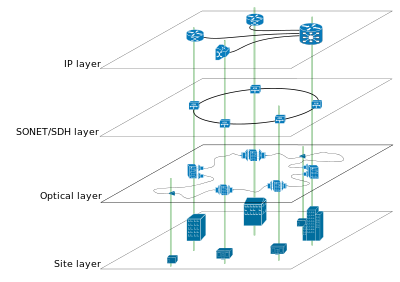Overlay mesh
An overlay network is a computer network that is based on an existing network (called an underlay). The main features of an overlay mesh are:
- (Logical) network above the existing infrastructure
- often own address space with own addressing (independent of the underlay)
- If necessary, use of your own route selection procedure
The overlay network is therefore used to set up an additional topology (physical, logical, structural ...). The newly created structure can be used, for example, to test current technologies such as IPv6 or to create alternative routes for the data. Peer-to-peer networks, such as Gnutella and Chord , are also built on an overlay network structure, which, for example, enables efficient searching and a certain network coordination. Further overlays can also be placed on these overlays, e.g. For example, for monitoring the P2P overlays, SkyEye is used, which introduces its own address space and brings its own protocols that require the functionality of the P2P overlays.
The Internet was in its infancy an overlay network over the existing telephone network. This is partly the case today, as there are still users who connect to the Internet via modem. In the meantime, however, the telephone network is increasingly becoming an overlay network based on the Internet thanks to VoIP .
Some examples of overlay meshes are:
- Content Addressable Network (CAN)
- Chord
- DiffServ (separates the physical network into several logical ones by dividing the network resources into different service classes)
- Freenet
- Gnutella , Gnutella2
- GNUnet
- I2P
- Kademlia
- Lightning network (virtualizes the exchange of information over different blockchain networks through atomic swaps)
- RetroShare
- MBone , 6Bone , ABone
- P-grid
- Pastry / tapestry
- PNRP
- RON
- goal
- XBone
- SkyEye
